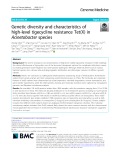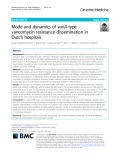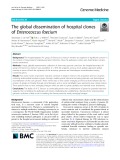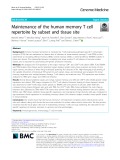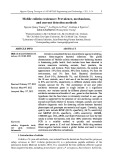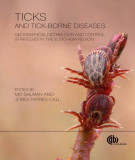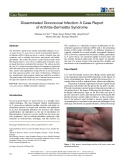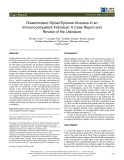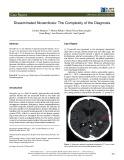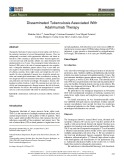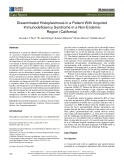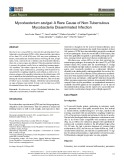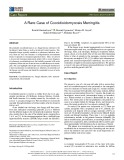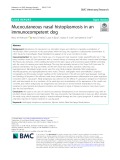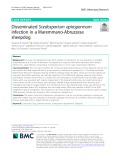
Disseminated infection
-
This volume describes the mechanisms which bacteria have created to secure their survival, proliferation and dissemination by subverting the actin cytoskeleton of host cells. Bacteria have developed a veritable arsenal of toxins, effector proteins and virulence factors that allow them to modify the properties of the intracellular actin cytoskeleton for their own purposes.
 249p
249p  vimeyers
vimeyers
 29-05-2024
29-05-2024
 3
3
 2
2
 Download
Download
-
The recent emergence and dissemination of high-level mobile tigecycline resistance Tet(X) challenge the clinical effectiveness of tigecycline, one of the last-resort therapeutic options for complicated infections caused by multidrug-resistant Gram-negative and Gram-positive pathogens.
 13p
13p  vibransone
vibransone
 28-03-2024
28-03-2024
 4
4
 2
2
 Download
Download
-
Enterococcus faecium is a commensal of the gastrointestinal tract of animals and humans but also a causative agent of hospital-acquired infections. Resistance against glycopeptides and to vancomycin has motivated the inclusion of E. faecium in the WHO global priority list.
 18p
18p  vibransone
vibransone
 28-03-2024
28-03-2024
 6
6
 2
2
 Download
Download
-
The hospital-adapted A1 group of Enterococcus faecium remains an organism of significant concern in the context of drug-resistant hospital-associated infections. How this pathogen evolves and disseminates remains poorly understood.
 12p
12p  vibransone
vibransone
 28-03-2024
28-03-2024
 4
4
 2
2
 Download
Download
-
Immune-mediated protection is mediated by T cells expressing pathogen-specific T cell antigen receptors (TCR) that are maintained at diverse sites of infection as tissue-resident memory T cells (TRM) or that disseminate as circulating effector-memory (TEM), central memory (TCM), or terminal effector (TEMRA) subsets in blood and tissues.
 14p
14p  vibransone
vibransone
 28-03-2024
28-03-2024
 5
5
 1
1
 Download
Download
-
Streptococcus pneumoniae is a gram-positive opportunistic pathogen, and infection risks of S. pneumoniae can be profoundly augmented by its acquired multidrug-resistance (MDR). The rapid development of MDR in S. pneumoniae was attributed to the international dissemination of a small number of multidrug-resistant “clones.”
 13p
13p  vicwell
vicwell
 29-02-2024
29-02-2024
 1
1
 1
1
 Download
Download
-
Colistin is considered the last-line antibiotic against multidrugresistant Gram-negative bacterial infections. The global dissemination of Mobile colistin resistance mcr-harboring bacteria is threatening public health. Such isolates have been detected in various reservoirs including animals, food products, the environment, and humans.
 12p
12p  vibego
vibego
 02-02-2024
02-02-2024
 5
5
 0
0
 Download
Download
-
Ebook Current diagnosis & treatment rheumatology (3rd edition): Part 2 includes contents: Disseminated gonococcal infection, whipple disease, rheumatic fever, endocrine & metabolic disorders, pulmonary hypertension, musculoskeletal ultrasound, pregnancy & rheumatic diseases,... and other contents.
 643p
643p  longtimenosee03
longtimenosee03
 30-01-2024
30-01-2024
 4
4
 2
2
 Download
Download
-
Part 1 book "Ticks and tick-borne diseases - geographical distribution and control strategies in the Euro-Asia region" includes content: Emerging (re emerging) tick borne infections and the dissemination of ticks; basic biology and geographical distribution of tick species involved in the transmission of animal pathogens, including zoonoses; factors influencing the spread and distribution of ticks; tick borne infections (including zoonoses) in europe and the mediterranean basin; maps of reported occurrence of tick borne pathogens.
 113p
113p  muasambanhan02
muasambanhan02
 18-12-2023
18-12-2023
 3
3
 0
0
 Download
Download
-
The bacteremic spread of the sexually transmitted pathogen, Neisseria gonorrhoeae (N. gonorrhoeae), results in disseminated gonococcal infection (DGI), which can lead to a variety of clinical signs and symptoms, such as multiple skin lesions, tenosynovitis and arthralgias/arthritis.
 3p
3p  viintuit
viintuit
 26-09-2023
26-09-2023
 3
3
 0
0
 Download
Download
-
The incidence and prevalence of nontuberculous mycobacterial disease is increasing due to enhanced clinician awareness and improved detection methods. The species identification using molecular microbiology techniques allows a better understanding of the differences in pathogenicity and treatment response.
 2p
2p  viintuit
viintuit
 26-09-2023
26-09-2023
 0
0
 0
0
 Download
Download
-
Spinal epidural abscess (SEA) is an uncommon pyogenic infection, localized between the dura mater and vertebral periosteum, leading to significant morbidity and mortality. SEA development is connected with medical comorbidities and risk factors facilitating bacterial dissemination; multiple factors are believed to play a role, including aging, increased alcohol abuse, use of intravenous drugs, a greater prevalence of medical comorbidities, and increased rates of spinal surgery that furthers iatrogenic spinal infection.
 9p
9p  viintuit
viintuit
 26-09-2023
26-09-2023
 3
3
 0
0
 Download
Download
-
Nocardiosis is a rare infection in immunocompetent patients. Nocardia spp. is an uncommon cause of prostate abscesses and is responsible for only 1-2% of brain abscess. Hematogenous dissemination can occur, and presentation of abscesses in more than two locations is required to determine a disseminated nocardiosis.
 4p
4p  viintuit
viintuit
 26-09-2023
26-09-2023
 2
2
 0
0
 Download
Download
-
Therapeutic blockade of tumour necrosis factor alpha (anti-TNF-α) is the mainstay treatment of several rheumatologic diseases. They are unfrequently associated with opportunistic infections and latent tuberculosis (TB) screening is paramount before immunosuppression. A 62-year-old man with psoriatic arthritis was under treatment with adalimumab for over 5 years.
 4p
4p  viintuit
viintuit
 26-09-2023
26-09-2023
 2
2
 0
0
 Download
Download
-
Histoplasmosis is caused by infection with Histoplasma capsulatum (H. capsulatum). Progressive disseminated histoplasmosis is a more severe form of histoplasmosis and is seldom diagnosed in non-endemic regions of the world owing to the fungus’s geographical distribution.
 5p
5p  viintuit
viintuit
 26-09-2023
26-09-2023
 1
1
 0
0
 Download
Download
-
Mycobacterium szulgai (MS) is a rare and slow-growing type of nontuberculous mycobacteria (NTM), with a human isolation prevalence of less than 0.2% of all NTM cases. MS may cause pulmonary infection, extra-pulmonary localized disease involving the skin, lymph nodes, bone, synovial tissue or kidneys and disseminated infection, when two or more organs are affected.
 5p
5p  viwhitewolf
viwhitewolf
 03-07-2023
03-07-2023
 7
7
 2
2
 Download
Download
-
Fitz-Hughs-Curtis syndrome is a manifestation of pelvic inflammatory disease (PID) which begins with sexually transmitted organisms such as Chlamydia trachomatis (C. trachomatis) and, less commonly Neisseria gonorrhoeae. The infection is hypothesized to disseminate into the peritoneum via lymphatic, hematogenous, or ascending spread of the organisms.
 6p
6p  viwhitewolf
viwhitewolf
 03-07-2023
03-07-2023
 4
4
 2
2
 Download
Download
-
Disseminated coccidioidomycosis is a fungal disease endemic to the Southwest United States as well as South and Central America. This dimorphic fungus typically manifests as pulmonary infection; however, there are very rare instances of extrapulmonary disseminated disease especially in immunocompromised hosts.
 7p
7p  viwhitewolf
viwhitewolf
 03-07-2023
03-07-2023
 5
5
 2
2
 Download
Download
-
Histoplasma (H.) capsulatum is a dimorphic fungus, and infection is typically via inhalation of microconidia. After conversion to the yeast phase within the lung, the organism is subsequently disseminated to other tissues by macrophages. Nasal histoplasmosis appears to be a rare condition in dogs.
 9p
9p  vidarwin
vidarwin
 23-02-2022
23-02-2022
 12
12
 2
2
 Download
Download
-
Few cases of scedosporiosis have been reported in animals, but the true prevalence is probably underestimated due to a lack of awareness. Scedosporiosis in dogs has often been associated with localized infection (i.e., nasal infection, eumycetoma, or keratomycosis) or, in rare cases, disseminated infections.
 5p
5p  vigandhi
vigandhi
 23-02-2022
23-02-2022
 7
7
 1
1
 Download
Download
CHỦ ĐỀ BẠN MUỐN TÌM









